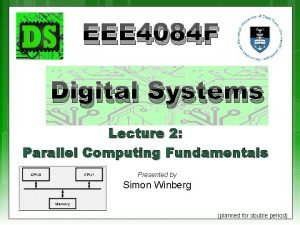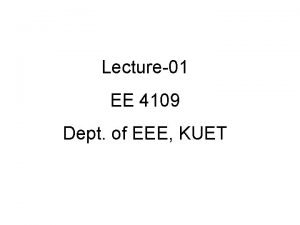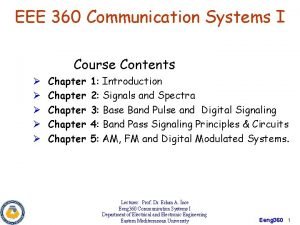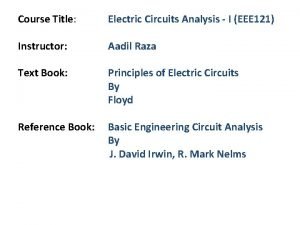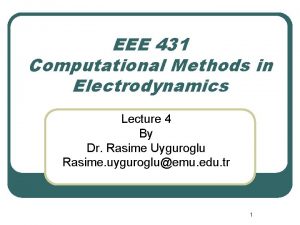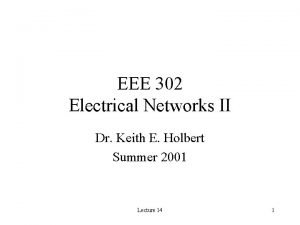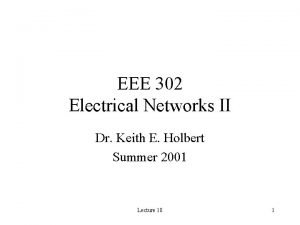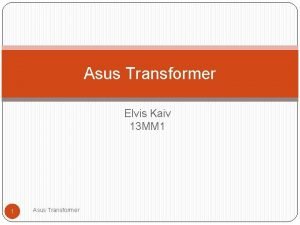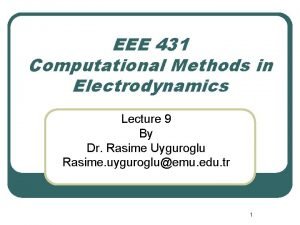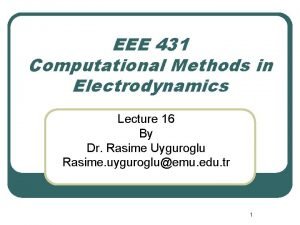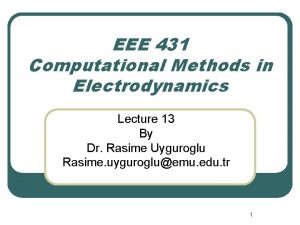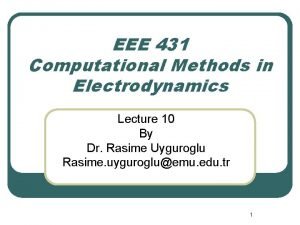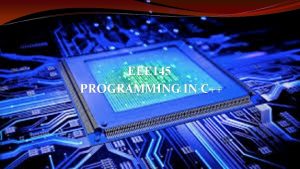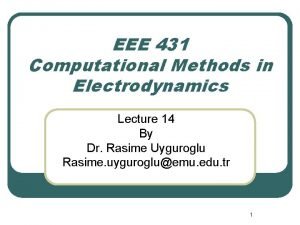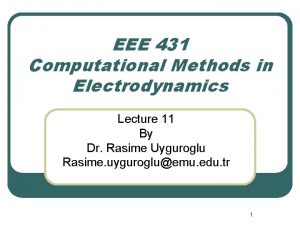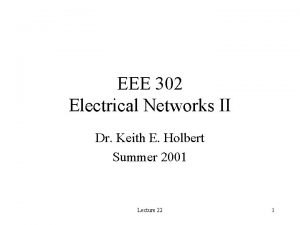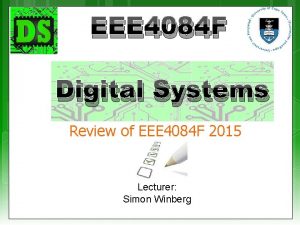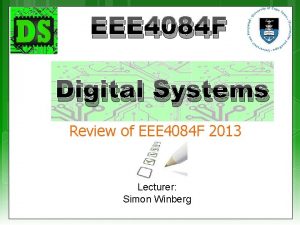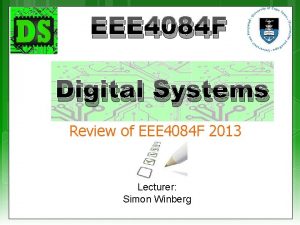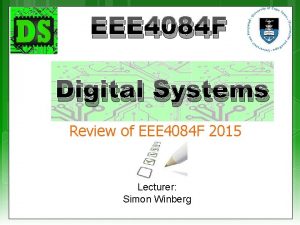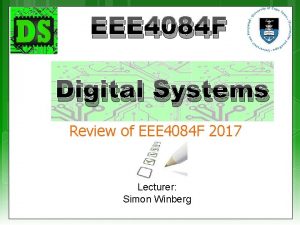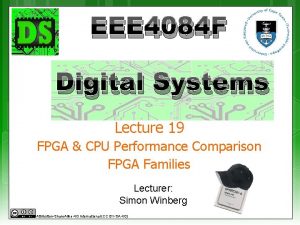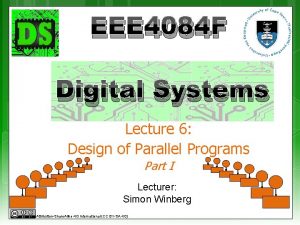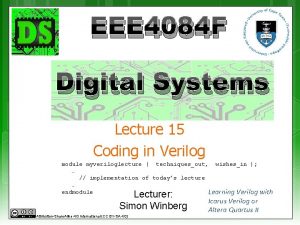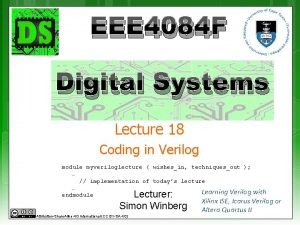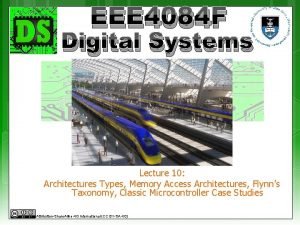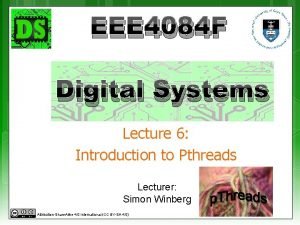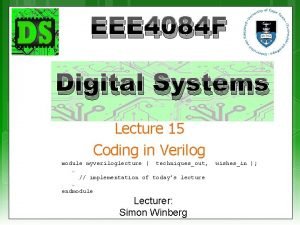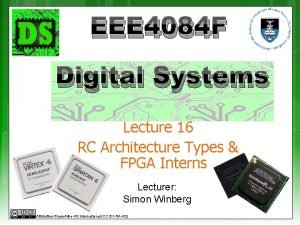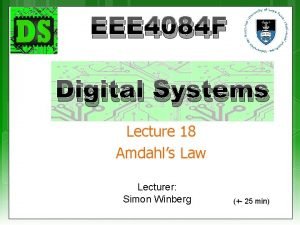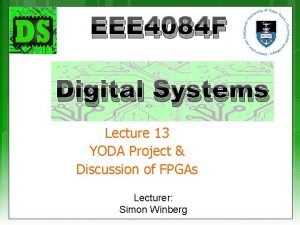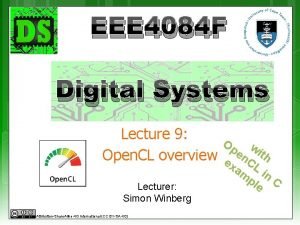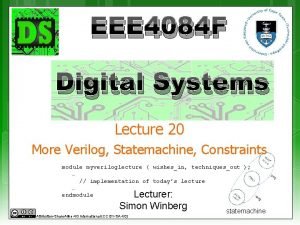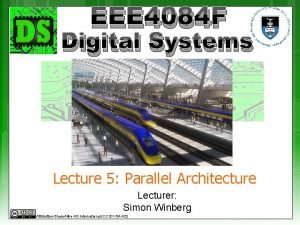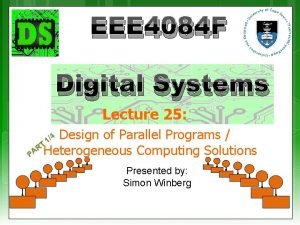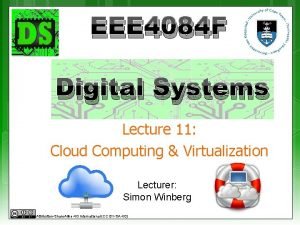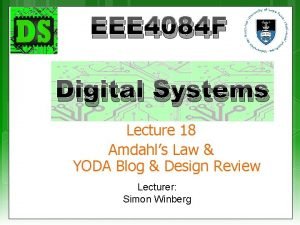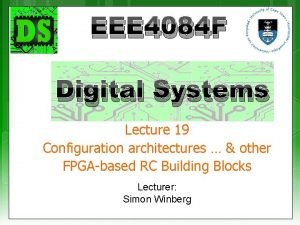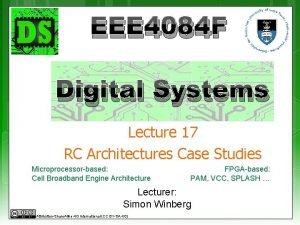EEE 4084 F Digital Systems Lecture 9 Deep

































- Slides: 33

EEE 4084 F Digital Systems Lecture 9: Deep. QA, GPUs & GPGPU (intended as a double period lecture) Lecturer: Simon Winberg Attribution-Share. Alike 4. 0 International (CC BY-SA 4. 0) What is ‘elementary’, my dear…?

First some clarifications… Bandwidth = Message size / Transmission time Total latency = Sending overhead + Transmission time + time of flight + Receiver overhead Effective bandwidth = Message size / Total latency = Throughput = Message size Sending overhead Transmission latency + Message size Bandwidth Only valid when the line carries one message at a time. Transmission time Time of flight Transmission time Transport latency Total latency Receive overhead

Lecture Overview Aside: IBM Watson (a mega ‘game console’ case study) Parallel Programming cont. Identifying Data Dependencies Synchronization GPU and GPGPU (Blackboard Lecture)

A short case study of a high performance computing system • Deep. QA project and • The Watson machine • A seriously expensive game console!?

IBM Deep. QA (as in Question and Answer)* A natural language processing system Can precisely answer questions expressed over a broad range of knowledge areas. Deep. QA Machine Deep. QA Architecture Image sources: http: //researcher. ibm. com/researcher/view_page. php? id=2159

IBM Deep. QA Motivation for the Deep. QA project Current computers store and deliver much digital content, but can’t operate on it in human terms. A quest for building a computer system that can do Open-domain Question Answering… *Read more at: http: //www. research. ibm. com/deepqa. shtml

IBM Deep. QA Ultimately driven by a broader vision: Get computers to operate more effectively in human terms rather in computer terms. Spoil sport, Surely not! I you lost as What is a game Is there a game think it’s a other than Jeopardy that is game. You didn’t ask that you can stupid something. Say what? only respond in played in that way? questions? Get computers to function in ways that understand complex information requirements (as people would express them), e. g. responding to natural language questions or requests. *Read more at: http: //www. research. ibm. com/deepqa. shtml

IBM Watson… a short film Putting Deep. QA to the test https: //www. youtube. com/watch? v=FC 3 Iry. Wr 4 c 8 https: //www. youtube. com/watch? v=Dyw. O 4 zksf. Xw

The IBM Watson Jeopardy was chosen as a game that makes significant cognitive demands on its payers. It involves questions and answers, but structuring both in a specific manner that makes sense beyond the surface level of the question/answer text given. What has this shown us? A computer can be designed to pose meaningful answers to questions in a natural language. Watson as the supreme champion of Jeopardy* Beyond Jeopardy IBM is planning to apply the Watson system design in areas such as healthcare, customer service, finance… etc. I wonder how great this will be in reality… * http: //www. geek. com/articles/geek-cetera/how-ibms-watson-could-have-been-beaten-in-jeopardy-20110226/

IBM Deep. QA : where could it lead? . . .

Future aftermath of Deep. QA? ? How may I help you today? I’d like to check my bank balance. Scenario… What the $&%# !! Bring back the touch -tone menu options! When was the first bank in England opened? I don’t know. Please, I need to check my balance! The famous Battle of Waterloo tipped the balance of power for what emperor in 1815?

IBM Deep. QA : where could it lead? “Can a robot write a symphony? Can a robot turn a. . . canvas into a beautiful masterpiece? ” << I am putting myself to the fullest possible use, which is all I think that any conscious entity can ever hope to do. >> << Can you? >> << Well, I can act without a conscious. >> No! But I can act. … and I have a conscious (I think)

Back to more serious stuff… Design of Parallel Programs (CONT) EEE 4084 F

Step 5: Identify Data Dependencies EEE 4084 F

Data dependencies A dependency exists between statements of a program when the order of executing the statements affects the results of the program. A data dependency is caused by different tasks accessing the same variables (i. e. , memory addresses). Dependencies are a major inhibition to developing parallel programs.

Data dependencies Common approaches to working around data dependencies: For distributed memory architectures: tend to use synchronization points (periods when sets of shared data is communicated between tasks). Shared memory architectures: make use of read/write synchronize operations (no sending of data, just temporarily block other tasks from reading/writing a variable).

Common data dependencies • Loop carried data dependence between statements in different iterations • Loop independent data dependence between statements in the same iteration • Lexically forward dependence: source precedes the target lexically • Lexically backward dependence: opposite from above • Right-hand side of an assignment precede the left-hand side Source: http: //sc. tamu. edu/help/powerlearn/html/Scalar. Optnw/tsld 036. htm

Design of Parallel Programs Step 6: Synchronization EEE 4084 F

Types of Synchronization Barrier Locking / Semaphores Synchronous communication operations

Barrier All tasks are involved Each task does work until it reaches the barrier, and then blocks. When the last task reaches the barrier all the tasks are synchronized. What happens next? … of work is done or Tasks are automatically released to continue their work… programmer usually decides. Section

Locking / Semaphores May concern any number of tasks Usually used to serialize / protect access to global data or critical section of code. Only one task at a time may have the lock / semaphore. Tasks can attempt to get the lock need to wait for the task that has the lock to release it, granted on a FCFS basis. Usually blocking, could be non-blocking (i. e. , do other work until lock is available)

Synchronous communication operations Concerns only tasks executing a communication operation (or coms op) When a task performs a coms op, some form of coordination is required with other task(s) involved with this communication. For example, before a task can do a send operation, it needs to first receive a clear to send (CTS) signal from the task it wants to send to.

Questions? ? ? ? ?

Blackboard lecture… GPUs… Which were inspired by computer games… Followed by some reference slides…

Graphics Processing Unit (GPUs) A graphics processing unit (GPU or VPU for ‘visual processing unit’) is a specialized processor that the main processor can offload graphics processing to (e. g. , 3 D rendering) In a personal computer or notebook, the GPU is often directly on the motherboard (but there are usually less powerful than those on dedicated video cards) GPUs are not restricted to PCs – but are also in embedded systems, mobile phones and game consoles, among other platforms.

GPUs are very efficient at manipulating computer graphics, but are not limited to this type of application… The highly parallel structure of modern GPUs often make them more effective than general-purpose CPUs for various types of algorithms (e. g. , vector and matrix processing).

CUDA = ‘Compute Unified Device Architecture’ Developed by NVIDIA see: http: //www. nvidia. com/object/cuda_home_new. html Programmers use C for CUDA (a flavor of C with special n. Vidia extensions), compiled using the Path. Scale Open 64 C compiler Visit Cuda. Zone for interesting examples of CUDA applications http: //developer. nvidia. com/category/zone/cuda-zone

CUDA kernel the (_kernel. cu file) is executed as an array of threads All threads run the same code (SIMD) Each thread has a different ID (used to indicate the memory location or partition it should use) Each block is an array of threads (each block has the same number of threads) thread. Dim: The number of threads in each block. thread. ID One block in CUDA: block. ID = 0 0 1 2 3 4 5 6 7 thread. Dim = 8 for this example

CUDA: threads thread. ID One block in CUDA: Private local vars 0 1 2 3 4 5 6 7 // C kernel program int* x = &data[thread. ID*N]; int i, sum=0; for (i=0; i<N; i++) sum+= data[i]; output[thread. ID] = sum; Shared global vars Each local variable in the kernel function is instantiated separately for each thread

CUDA: blocks of threads thread. ID 0 1 2 3 4 5 6 7 // C kernel program int* x = &data[thread. ID*N]; int i, sum=0; for (i=0; i<N; i++) sum+= data[i]; output[thread. ID] = sum; block. ID. x = 0 thread. ID 0 1 2 3 4 5 6 7 // C kernel program int* x = &data[thread. ID*N]; int i, sum=0; for (i=0; i<N; i++) sum+= data[i]; output[thread. ID] = sum; block. ID. x = 1 thread. ID 0 1 2 3 4 5 6 7 // C kernel program int* x = &data[thread. ID*N]; int i, sum=0; for (i=0; i<N; i++) sum+= data[i]; output[thread. ID] = sum; block. IDx = block. Dim. x -1 Note: the above visual depicts only one row in the array of blocks!! Only threads in the same block can cooperate, e. g. , via atomic operations, shared memory, or barrier synchronization. The __shared keyword indicates a local variable shared between all threads in the same block (i. e. , declared in the kernel function). All threads can access the global memory, which is copied over to the GPU from the CPU (using cuda. Memcpy(cpu_p, gpu_p, size, cuda. Memcpy. Host. To. Device)).

CUDA block dimensions It’s a massive 2 D collection of CPUs! Block. ID. x = 0, Block. ID. y = 0 ( Block. Dim. x , Block. Dim. y ) … … … … … Block. ID : a coordinate structure indicating the current block ID Block. Dim : a coordinate structure indicating the number of block IDs Block. ID. x = Block. Dim. x-1, Block. ID. y = Block. Dim. y-1

Next lecture Load balancing (step 7) Performance Benchmarking (step 8) Heading towards. . . end of parallel programming series

Disclaimers and copyright/licensing details I have tried to follow the correct practices concerning copyright and licensing of material, particularly image sources that have been used in this presentation. I have put much effort into trying to make this material open access so that it can be of benefit to others in their teaching and learning practice. Any mistakes or omissions with regards to these issues I will correct when notified. To the best of my understanding the material in these slides can be shared according to the Creative Commons “Attribution-Share. Alike 4. 0 International (CC BY-SA 4. 0)” license, and that is why I selected that license to apply to this presentation (it’s not because I particulate want my slides referenced but more to acknowledge the sources and generosity of others who have provided free material such as the images I have used). Image sources: Camera real - open commons Boom barrier - Wikipedia (open commons) IBM Watson images – from both Wikipedia and www. ibm. com (minor edits made) Film real – Pixabay http: //pixabay. com/ HAL - Wikipedia (open commons) Computer graphics collage – various sources Geforce 7800 gt GPU - Wikipedia (open commons) Lock and key, Checked Flag - Open Clipart (http: //openclipart. org)
 Q6 4084
Q6 4084 01:640:244 lecture notes - lecture 15: plat, idah, farad
01:640:244 lecture notes - lecture 15: plat, idah, farad Deep asleep deep asleep it lies
Deep asleep deep asleep it lies Deep forest: towards an alternative to deep neural networks
Deep forest: towards an alternative to deep neural networks 深哉深哉
深哉深哉 Epaxial muscle dog
Epaxial muscle dog Eee kuet
Eee kuet Eee 360
Eee 360 Ankara university
Ankara university Eee 121
Eee 121 Eee 431
Eee 431 Eee 302
Eee 302 Eee 302
Eee 302 Tahvel.edu.eee
Tahvel.edu.eee Eee 431
Eee 431 Eee 431
Eee 431 Eee 431
Eee 431 Eee 431
Eee 431 Eee 145
Eee 145 Lecc
Lecc Lempel-ziv coding in digital communication
Lempel-ziv coding in digital communication Eee 431
Eee 431 Eee 431
Eee 431 3 phase short circuit
3 phase short circuit Eee 302
Eee 302 Dot product
Dot product Eee
Eee Animacionet
Animacionet Eee
Eee Android asus eee pc
Android asus eee pc Hku eee lab
Hku eee lab Pdf cute
Pdf cute Diu eee faculty
Diu eee faculty String conversion
String conversion
